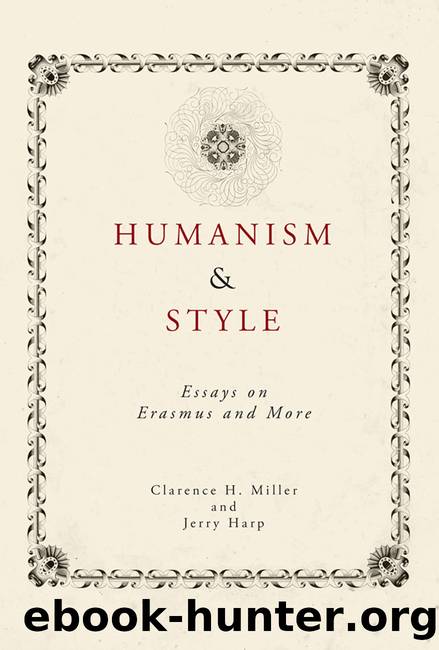Humanism and Style by Miller Clarence H.;

Author:Miller, Clarence H.;
Language: eng
Format: epub
ISBN: 1767211
Publisher: Lehigh University Press
7
Moreâs Use of Patristic Evidence in the Eucharistic Controversy
MOREâS POLEMICAL WRITINGS DEFENDING THE Real Presence in the Eucharist tend to reflect a more general pattern: eucharistic controversy stimulated, and was stimulated by, more and more intensive study of the church fathers.1 And Moreâs treatment of this very complex issue was adapted to the stage which the argumentation had reached by 1533, when he wrote The Answer to a Poisoned Book2 in response to The Souper of the Lord, a Zwinglian attack on the Real presence. When the controversy first sprang up in the 1520s, patristic evidence seemed to be of no special importance. In the five German pamphlets that Karlstadt published at Basel during the fall of 1524,3 he relied on the fathers hardly at all. But then almost no one took his arguments seriously anyway. Melanchthon was not far from the general view of Karlstadt when he said: âKarlstadt was the first one to stir up this stormâa beastly man, without intelligence, without learning, without common sense.â4
Zwingliâs first treatise denying the real presence, his letter to Alber (March 1525),5 and the five learned sacramentarian tracts that he published over the next two years attempt to make sacramentarianism tenable and respectable. But his arguments are primarily biblical and dialectical, not patristic. He insists that est in the biblical accounts means significat and that edere means credere, citing analogies from texts about the paschal lamb, manna, circumcision, or Christ as the rock or door or vine. He argues that Christâs physical presence in the eucharist would contradict the truth of his ascension and the union of the divine and human natures in his person. Only in his second eucharistic treatise, the long section of De vera et falsa religione commentarius that became the source of The Souper, does he give a catena of passages from Tertullian, Augustine, Hilary, Jerome, and Origen.6 His patristic evidence is not very strong. He himself admits that one passage from Jerome is hardly relevant, and in his next eucharistic treatise five months later, he remarks that he had intended to appeal once more to the testimony of the fathers but found it no longer necessary because Oecolampadius had already provided an ample stream of patristic evidence against the real presence.7
Oecolampadius was indeed in a better position than Zwingli to bring the fathers fully into the fray8 and had done so by August 1525 in his famous or notorious De genuina verborum domini, Hoc est corpus meum, iuxta vetustissimos authores, expositione liber (âAn authentic Exposition of the words of the lord, This is my body, according to the most ancient authoritiesâ).9 In the 1520s, Oecolampadius had few rivals in knowledge of the fathersâespecially the Greek fathersâperhaps only Melanchthon and Erasmus himself. He had made a compendious index (1520) of Erasmusâs great edition of Jerome; before 1525, he had published translations of large parts of Chrysostom, Cyril of Alexandria, and Gregory of Nazianzus. His translation of Theophylactusâ commentaries on the four gospels had appeared in 1524.10 Hence it
Download
This site does not store any files on its server. We only index and link to content provided by other sites. Please contact the content providers to delete copyright contents if any and email us, we'll remove relevant links or contents immediately.
Housekeeping by Marilynne Robinson(4043)
Papillon (English) by Henri Charrière(3887)
The Poetry of Pablo Neruda by Pablo Neruda(3799)
World without end by Ken Follett(3335)
TCP IP by Todd Lammle(2999)
Fluent Forever: How to Learn Any Language Fast and Never Forget It by Gabriel Wyner(2903)
The Rape Of Nanking by Iris Chang(2632)
How Proust Can Change Your Life by Alain De Botton(2601)
The Alchemist by Paulo Coelho(2577)
The Partner by John Grisham(2274)
Two lives by Helen Naylor(2181)
Hitler by Ian Kershaw(2037)
Yerma by Federico García Lorca(1911)
Sophie's World by Jostein Gaarder(1892)
Smilla's Sense of Snow by Peter Hoeg(1843)
Merriam-Webster's Pocket Dictionary by Merriam-Webster(1810)
Il cavaliere inesistente by Italo Calvino(1778)
Twilight of Idols and Anti-Christ by Friedrich Nietzsche(1751)
Deep Writing by Eric Maisel(1732)
